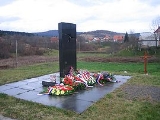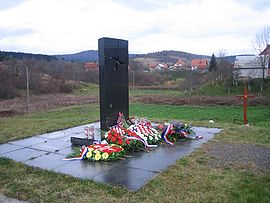
Saborsko massacre
Encyclopedia


War crime
War crimes are serious violations of the laws applicable in armed conflict giving rise to individual criminal responsibility...
committed during the Croatian War of Independence
Croatian War of Independence
The Croatian War of Independence was fought from 1991 to 1995 between forces loyal to the government of Croatia—which had declared independence from the Socialist Federal Republic of Yugoslavia —and the Serb-controlled Yugoslav People's Army and local Serb forces, with the JNA ending its combat...
in Saborsko
Saborsko
Saborsko is a village and municipality in Karlovac county, Croatia. The municipality is part of Lika.- Geography :It is country-side mountain resort, situated in a curved, long and narrow valley. The altitude of the place is 630-900 m...
and two other Croatia
Croatia
Croatia , officially the Republic of Croatia , is a unitary democratic parliamentary republic in Europe at the crossroads of the Mitteleuropa, the Balkans, and the Mediterranean. Its capital and largest city is Zagreb. The country is divided into 20 counties and the city of Zagreb. Croatia covers ...
n villages in the region of Kordun
Kordun
The Kordun region is a part of central Croatia from the bottom of the Petrova Gora mountain range, which extends along the rivers Korana and Slunjčica, and forms part of the border region to Bosnia and Herzegovina. The southern border of Kordun touches the Lika region...
by the Serb-led JNA
Yugoslav People's Army
The Yugoslav People's Army , also referred to as the Yugoslav National Army , was the military of the Socialist Federal Republic of Yugoslavia.-Origins:The origins of the JNA can...
and rebel Croatian Serbs' "Militia of Republic of Serb Krajina" in October and November 1991, in which they killed local Croats
Croats
Croats are a South Slavic ethnic group mostly living in Croatia, Bosnia and Herzegovina and nearby countries. There are around 4 million Croats living inside Croatia and up to 4.5 million throughout the rest of the world. Responding to political, social and economic pressure, many Croats have...
.
Background
An important fact about the JNA was about its leadership, as well as its ethnical structure of troops (army obligants, reserves, officers). Although JNA (Yugoslav National Army) wore the name of Yugoslavia, the ethnical structure of JNA' soldiers engaged was not representing the ethnical structure of Yugoslavia; it had no army obligants from Croatia and Slovenia, nor Croats from Bosnia and Herzegovina, so the share of Serbs became extremely higher. That was because of ending of regular one-year military service - one of "big" classes ended its service at the end of August and the beginning of September, and after the December of 1991, the recruitmenet percentage from those republics sharply dropped. The class of June had no recruits from Croatian and Slovenia at all. The other important factors, that influenced changed army's ethnical structure was the deserting of army during the service (mostly non-Serb soldiers from Croatia and Croats from Bosnia-Herzegovina), higher percentage of relieving from army obligation (medical and other reasons) during the service (much higher than usual) and various evading steps undertaken before the start of military service. Additionally, reserve forces were recruited from Serbia and Montenegro (the latter were, however, engaged on southern Croatian battlefield). Similar was with army's professional personnel (officers, experts, tehnicians).The assault on Saborsko region
According to the census of 1991, Saborsko had 1,701 inhabitants in 460 households. The majority were the autochthonous CroatsCroats
Croats are a South Slavic ethnic group mostly living in Croatia, Bosnia and Herzegovina and nearby countries. There are around 4 million Croats living inside Croatia and up to 4.5 million throughout the rest of the world. Responding to political, social and economic pressure, many Croats have...
. Local Serb paramilitaries had started with attacks on Croat villages on October 1, 1991, with military support of JNA forces from Knin. Among other attacks, these forces had attacked Saborsko, a small village located some 10 kilometers northwest from Plitvička Jezera
Plitvicka Jezera
Plitvička Jezera is a municipality in central Croatia, in the eastern part of the Lika-Senj county, that lies in and near the eponymous Plitvice Lakes National Park, bisected by the D1 main road . Its total area is 539.08 km². The main town and seat of the municipality is Korenica...
.
The assault, ICTY sources confirm, was a part of the ethnic cleansing
Ethnic cleansing
Ethnic cleansing is a purposeful policy designed by one ethnic or religious group to remove by violent and terror-inspiring means the civilian population of another ethnic orreligious group from certain geographic areas....
plan. According to that plan, "all Croats and other non-Serbs were to be displaced from there, in order to get ethnically clean Republic of Serbian Krajina". Ethnically cleansed areas were used as jumpboards for the further assaults on other areas of Croatia.
- ""...Thus, the threat clearly expressed in Milan Martić's ultimatum in Kijevo was carried out in the territory of the SAO Krajina through the commission of widespread, grave crimes. This created an atmosphere of fear in which the further presence of Croats and other non-Serbs in the SAO Krajina was made impossible. The Trial Chamber has therefore concluded that the displacement of the Croat and other non-Serb population which followed these attacks was not merely the consequence of military action, but in fact its primary objective....
- From August 1991 and into early 1992, these combined forces attacked several Croat-majority villages and areas, including Hrvatska Kostajnica, Cerovljani, Hrvatska Dubica, BaćinBacin massacreThe Baćin massacre was a war crime committed by rebel Croatian Serbs' forces on October 21, 1991 on a location near village of Baćin, near Hrvatska Dubica, in central Croatia, during the Croatian War of Independence....
, Saborsko, Poljanak, Lipovača, ŠkabrnjaŠkabrnja massacreŠkabrnja massacre was a war crime committed by Serb Army forces during the Croatian War of Independence. On November 18, 1991, Serb paramilitaries, supported by the JNA, captured the village of Škabrnja and killed 25 Prisoners of war and 61 civilians over the next several days.-Before the...
and Nadin. Evidence shows the attacks were carried out to connect Serb villages and areas across non-Serb areas. During these attacks, the crimes of murder, destruction, plunder, detention, torture, and cruel treatment were committed against the non-Serb population..."
Massacres
On 28 October 1991, Territorial Defence Forces (TO) units killed seven civilians in the village of Lipovača, located east of Saborsko and RakovicaRakovica, Croatia
Rakovica is a village in south-central Croatia, in the region of Kordun south of Karlovac and Slunj, and north of the Plitvice Lakes. The total municipality population is 2,623 , while the village itself has 356 residents. According to that census, 91% are Croats and 3,58% are Serbs. Due to...
.
On 7 November 1991, the Yugoslav People's Army
Yugoslav People's Army
The Yugoslav People's Army , also referred to as the Yugoslav National Army , was the military of the Socialist Federal Republic of Yugoslavia.-Origins:The origins of the JNA can...
(JNA) and Serbian paramilitary units, in particular a special JNA unit from Niš
Niš
Niš is the largest city of southern Serbia and third-largest city in Serbia . According to the data from 2011, the city of Niš has a population of 177,972 inhabitants, while the city municipality has a population of 257,867. The city covers an area of about 597 km2, including the urban area,...
, Serbia
Serbia
Serbia , officially the Republic of Serbia , is a landlocked country located at the crossroads of Central and Southeast Europe, covering the southern part of the Carpathian basin and the central part of the Balkans...
, entered the hamlet of Vukovići
Vukovići
Vukovići is a village in the municipality of Hadžići, Bosnia and Herzegovina.-References:...
near Poljanak and executed ten civilians.
Poljanak is located southeast of Saborsko but southwest of Rakovica, around 10 km from both Lipovača and Saborsko.
On 12 November 1991, the attackers, consisting of members of "Martić
Milan Martic
Milan Martić is a Serbian politician, former president of the Republic of Serbian Krajina...
’s Police", the JNA, and the TO, breached the defense lines of the village of Saborsko.
After that, they went from house to house and killed peasants (in total 29 of them) that had been unable or unwilling to abandon the village. After that, all houses were plundered.
A Catholic church was blown up and the local graveyard was devastated by the attackers, presumably to remove all traces of previous Croat inhabitants.
Several of the villagers survived by sneaking three days through the forests into Bihać
Bihac
Bihać is a city and municipality on the river Una in the north-western part of Bosnia and Herzegovina, in the Bosanska Krajina region. Bihać is located in the Una-Sana Canton in the Federation of Bosnia and Herzegovina.-History:...
in neighboring Bosnia and Herzegovina
Bosnia and Herzegovina
Bosnia and Herzegovina , sometimes called Bosnia-Herzegovina or simply Bosnia, is a country in Southern Europe, on the Balkan Peninsula. Bordered by Croatia to the north, west and south, Serbia to the east, and Montenegro to the southeast, Bosnia and Herzegovina is almost landlocked, except for the...
, where they were accepted and then transferred to Croatia by buses, where they were given shelter with other refugees in hotels.
Altogether, in Saborsko, 29 people were killed in this event.
The assailants came from the village of Plaški
Plaški
Plaški is a village and a municipality in Karlovac County, Croatia. It is part of Lika.- Geography :Plaški is situated in the lower part of the Ogulin-Plaški valley. Together with Gorski kotar and Lika, the Ogulin-Plaški valley forms Mountainous Croatia...
, located around 10 km northwest of Saborsko.
External links
- ICTY: Martić (IT-95-11) "RSK"
- ICTY: Babić (IT-03-72) "RSK"
- BBC News Europe: Serb leader jailed for war crimes
Article in Glas koncila Article in Vjesnik from November 23, 2002, pdf format Article in Vjesnik from October 16, 2002 titled: Saborsko was attacked in order to encircle 'Serb territorry' "

